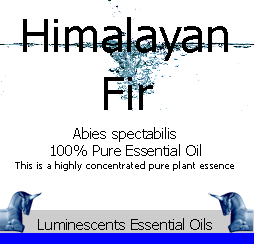Abies spectabilis from which Himalayan Fir Essential Oil is distilled is a conifer species in the family Pinaceae and the genus firs. It is sometimes held to include the Bhutan fir (Abies densa) as a variety. It is found in Afghanistan, China, Tibet, northern India, Nepal, and Pakistan.It is a large tree, up to 50 metres in height.
The tree has a wide distribution across the high elevations in the countries listed above , but it has suffered from logging and deforestation, especially at the lower elevations it grows.
In some areas it is considered as near threatened.
The leaves are needle-like, flattened, 3-6 cm long and 2 mm wide by 0.5 mm thick, glossy dark green above, and with two green-white bands of stomata below, and slightly notched at the tip. The leaf arrangement is spiral on the shoot, but with each leaf variably twisted at the base so they all lie in two more-or-less flat ranks on either side of the shoot. The cones are 6-12 cm long and 3.5-4.5 cm broad, with about 100-150 scales; the scale bracts are short, and hidden in the closed cone. The winged seeds are released when the cones disintegrate at maturity about 6 months after pollination.
Reported Attributes of Himalayan Fir Essential Oil:-
Traditional and Emotional uses reportedly include:-
This is a popular although much rarer oil than Siberian Fir and is used to bring out masculine, attributes to mens fragrances, bath preparations, air fresheners, herbal, moss, soaps, and shaving creams. Fir needle is reported to help with arthritis, bronchitis, colds, coughs, flu, muscle aches, rheumatism, sinusitis and, of course, aromatically is very evocative.
Himalayan Fir Essential Oil Blends Well With:-
Cedar Leaf, all Citrus oils, Galangal, Galbanum, Geranium, Ginger, Juniper Berry & Leaf, Labdanum, Laurel Bery & Leaf, Lavandin all the Lavenders.
Cautions:-
May cause skin irritation in some individuals if used in high concentrations.






